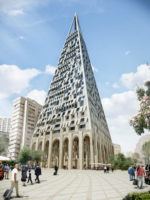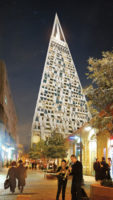The news that Jerusalem is to have a pyramid of its own, a skyscraper designed by Daniel Libeskind, has elicited mixed reactions. City officials say the stone-and-glass building will help revitalize the city center, and one expert hopes that world-class architecture will be a boon for the area. But critics have voiced concern that the luxury tower—with 200 apartments, a boutique hotel, a restaurant, and a ground-floor arcade of upscale shops—will exacerbate the phenomenon of ghost apartments in the city, that is, apartments owned by residents of other countries who visit Israel for only brief periods each year. Jerusalem has the highest concentration of such apartments in Israel, and the Libeskind project is one of several new luxury complexes in the city center aimed mainly at foreign buyers.
The 345-foot tower is set to rise near the Mahane Yehuda open-air produce market that is also an increasingly popular entertainment area at night. The Pyramid, as Libeskind calls his project, is to be Jerusalem’s second-tallest building.
Libeskind, who lived in Israel between 1957 and 1959, has designed one other project in the country so far: the Wohl Center, a conference center completed in 2005 at Bar-Ilan University in the Tel Aviv metropolitan area.
The site of the Pyramid is a 1.7-acre plot that formerly housed the Eden Cinema, which opened in 1928 as the Eden Hall Talkies. The building was abandoned after the cinema’s demise in 1990 and was demolished this past July. After approval by the Jerusalem Municipality, excavation work for the Libeskind tower began soon after.
The project’s design has changed considerably since it was first made public in 2007. Besides a 24-story tower (not a pyramid), it had two smaller buildings, one arching over the other. In 2011, when the municipal planning and construction committee posted the design for objections, the tower was reportedly 394 feet high. The committee’s chairman said that the project would “contribute to strengthening the city center.”
According to Studio Libeskind, the current tapering form was chosen “to allow maximum light to fall on the public plaza below and to create ample open space surrounding the structure.”
David Kroyanker, an expert on the architectural history of Jerusalem, says, “Libeskind’s buildings are very sophisticated,” and the success of the design “depends a lot on the details, the finish.” He welcomes the idea of a building of high quality, because the multistory buildings nearby are a “catastrophe, architecturally.”
But, although Studio Libeskind says “The Pyramid is set to become an integral part of the neighborhood, servicing citizens and tourists alike,” Kroyanker warns of the creation of more ghost apartments.
That concern is seconded by Ravit Hananel, a professor of urban planning at Tel Aviv University, who specializes in how housing policy affects society. She supervised a study by her student, Tamar Haramati of ghost apartments in Jerusalem and Tel Aviv.
Although Studio Libeskind described the project as becoming "an integral part of the neighborhood," Hananel sees the ultimate danger as the creation of not only more ghost apartments, but of yet another ghost neighborhood with reduced urban diversity.
Update 08/24/2015: Studio Libeskind confirms after press time that 20 percent of the Pyramid will be affordable housing.





